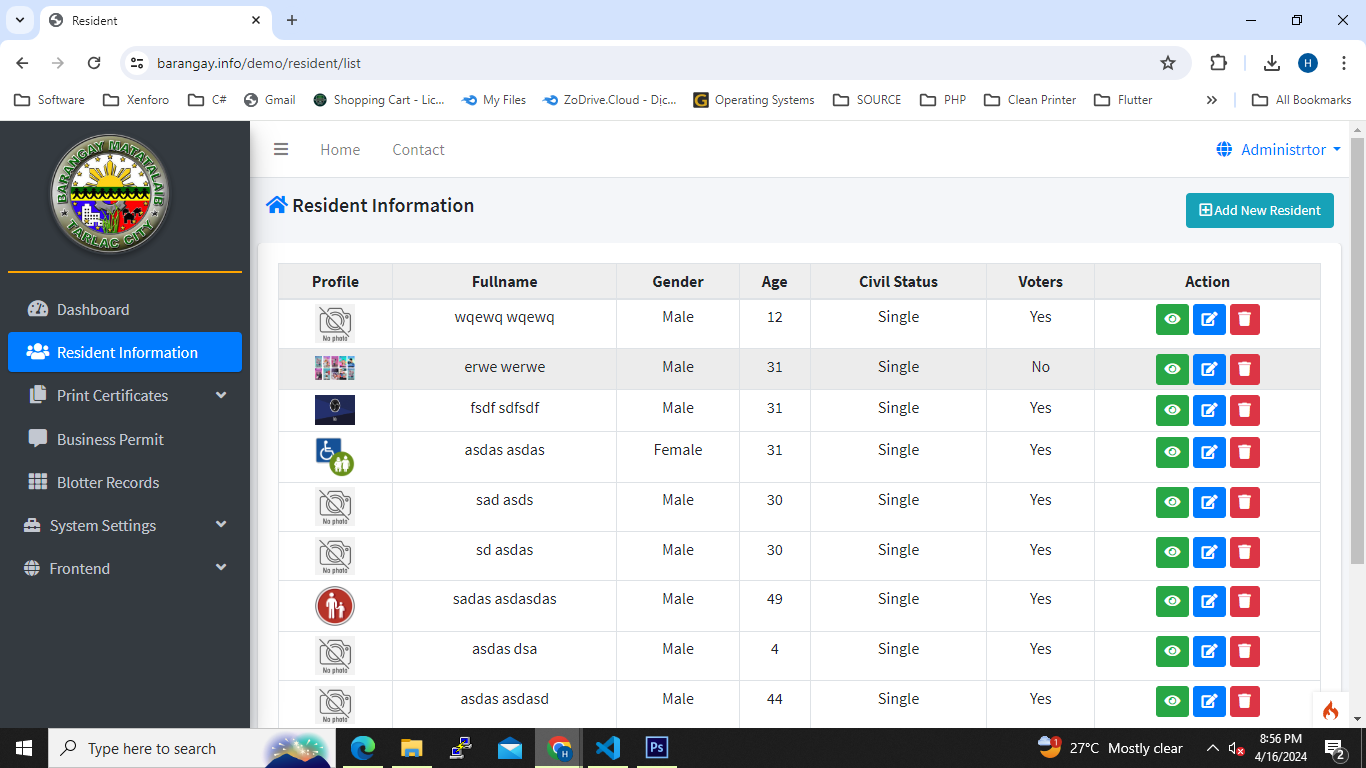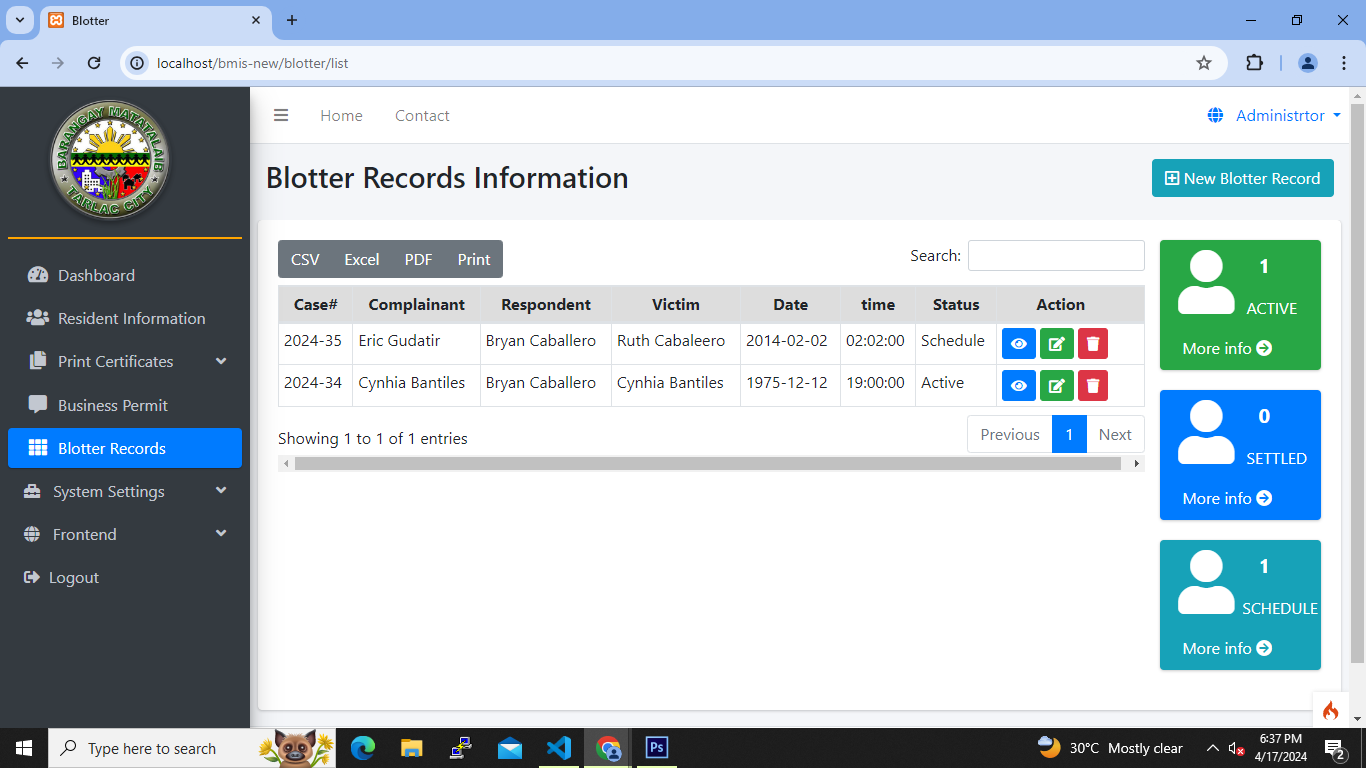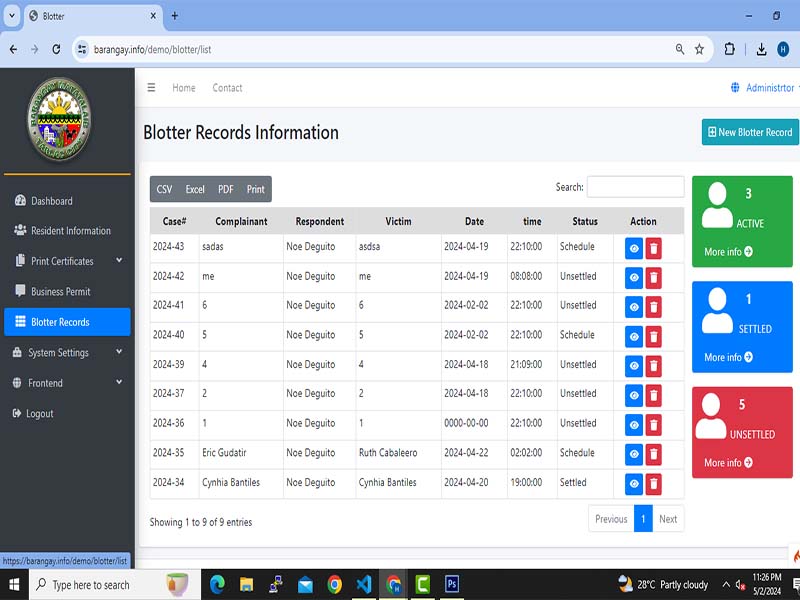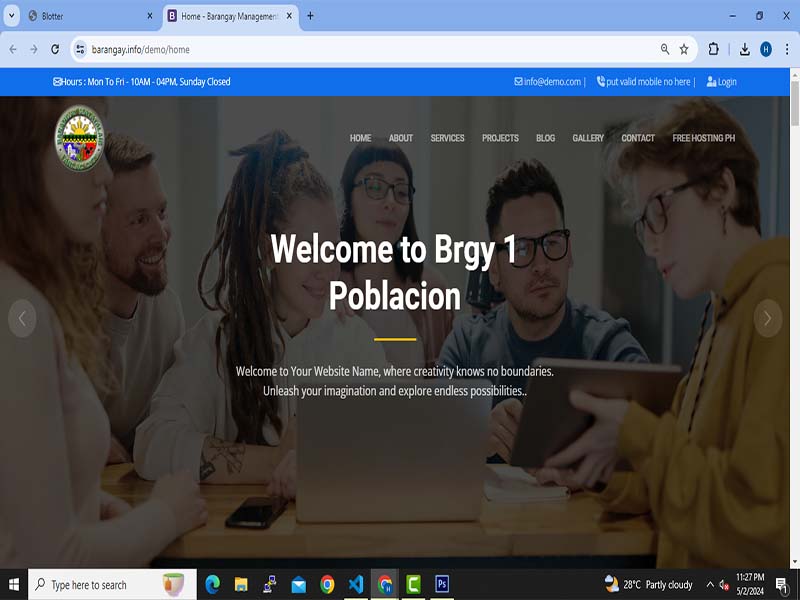Barangay History
The term "barangay" originated from balangay, a type of boat used by a group of Austronesian peoples when they migrated to the Philippines. In the 16th century, when the Spaniards arrived in the Philippines, they found well-organized, independent villages called barangays. These barangays were led by a chief and had populations ranging from a few hundred to thousands. The Spaniards later consolidated smaller barangays to form compact towns during their rule. When the Americans arrived, they made slight changes to the local government structure, renaming the barrio to barangay. The barangay system was established as the basic socio-political unit for cities in the early 1970s and was later replicated nationwide. The barangay is now the smallest unit of Philippine government, headed by elected officials, including the barangay captain and seven barangay councilors..
Modern Governance:
Today, barangays serve as the smallest administrative units in the Philippines. They are governed by elected officials, including a barangay captain (formerly known as a barangay captain or barangay chairman) and several barangay councilors.
Roles and Functions:
Barangays play crucial roles in delivering basic services to residents, such as health care, education, sanitation, and public safety. They also facilitate community development projects and serve as channels for citizen participation and local governance.
Challenges and Opportunities:
While barangays have been integral to Philippine society for centuries, they face various challenges in the modern era, including issues related to governance, infrastructure development, poverty alleviation, and disaster response. Efforts are ongoing to strengthen barangay governance, improve service delivery, and enhance community resilience.
Features
Check The Features
Happy Clients
Projects
Hours Of Support
Hard Workers

DASHBOARD MENU
A dashboard system is a user interface that provides a consolidated view of various data sources, metrics, and key performance indicators (KPIs) in a single place. Here are some key features commonly found in dashboard systems:
-
Customization: Users should be able to customize the dashboard according to their preferences and needs. This might include rearranging widgets, changing themes, or selecting which metrics to display.
-
Widgets: Dashboards typically consist of widgets, which are visual representations of data. Widgets can include charts, graphs, gauges, tables, maps, and more. Each widget should be interactive and provide drill-down capabilities for deeper analysis.
-
Data Integration: The ability to integrate data from various sources is crucial. Dashboard systems often support integration with databases, spreadsheets, APIs, and other data repositories to pull in real-time or batch data.
-
Data Visualization: Effective visualization techniques help users understand complex data quickly and easily. Dashboards should offer a variety of visualization options such as bar charts, pie charts, line graphs, heat maps, and scatter plots.
-
Real-time Updates: For monitoring live data or rapidly changing metrics, real-time updates are essential. Users should have the option to set refresh intervals or receive automatic updates as data changes occur.
-
Filters and Drill-downs: Users should be able to filter data and drill down into specific details to gain deeper insights. This might involve selecting a particular time range, region, product category, or any other relevant dimension.
-
Alerts and Notifications: Dashboard systems often include alerting capabilities to notify users of significant changes or anomalies in the data. Users can set thresholds or conditions for triggering alerts and receive notifications via email, SMS, or in-app notifications.
-
User Access Control: Role-based access control ensures that only authorized users can view or modify sensitive data on the dashboard. Administrators should be able to manage user permissions and restrict access to certain features or data sources.
-
Mobile Responsiveness: As users increasingly access applications from mobile devices, dashboard systems should be responsive and optimized for mobile viewing. This ensures usability and accessibility across different screen sizes and devices.
-
Performance Monitoring: In addition to displaying historical data, dashboards may also include performance monitoring features to track real-time system health, uptime, and performance metrics.
-
Export and Sharing: Users should be able to export dashboard views or specific data sets in various formats (e.g., PDF, CSV, Excel) for further analysis or sharing with colleagues.
-
Usage Analytics: Dashboard systems may include built-in analytics to track user interactions, such as which widgets are most frequently accessed or how often certain alerts are triggered. This feedback can help improve the usability and relevance of the dashboard over time.
By incorporating these features, dashboard systems can provide users with actionable insights, facilitate data-driven decision-making, and improve overall organizational efficiency.

ADD RESIDENT

RESIDENT INFORMATION
A "Resident Information" feature within a dashboard system typically focuses on providing comprehensive details about individuals residing within a particular community, housing complex, or any other residential setting. Here are some key components and functionalities that such a feature may encompass:
-
Profile Management: Users can create and manage profiles for each resident, including basic personal information such as name, contact details, age, gender, and family members.
-
Residency Details: Information related to residency status, duration of stay, move-in date, lease agreements, and occupancy status can be recorded and tracked.
-
Emergency Contacts: Residents can input and update emergency contact information, including names, relationships, phone numbers, and addresses of designated contacts to be notified in case of emergencies.
-
Unit/Property Details: Details about the residential unit or property assigned to each resident, such as unit number, building name, floor, and any special instructions or notes related to the accommodation.
-
Amenities Usage: Tracking the utilization of communal amenities or facilities within the residential complex, such as gyms, pools, community centers, parking spaces, and playgrounds. This may include reservation systems or usage logs to manage access and scheduling.
-
Communication Tools: Integration with communication channels for sending announcements, newsletters, or notifications to residents regarding community events, maintenance schedules, policy updates, or emergency alerts.
-
Community Services: Providing information about local services, utilities, transportation options, nearby schools, hospitals, grocery stores, and other amenities that may be relevant to residents.
-
Maintenance Requests: Residents can submit maintenance requests or service tickets directly through the dashboard system, detailing issues with their living space or communal areas. Property managers can then track, prioritize, and resolve these requests efficiently.
-
Billing and Payments: Integration with billing systems to facilitate rent payments, utility bills, maintenance fees, or other charges associated with residential living. Residents can view their payment history, outstanding balances, and payment schedules.
-
Document Management: Securely storing and managing important documents related to residency, such as lease agreements, rental contracts, community rules, insurance policies, and notices from property management.
-
Visitor Management: Recording information about visitors or guests, including their names, contact details, purpose of visit, and duration of stay. This helps maintain security and track visitor activity within the residential premises.
-
Privacy and Security: Implementing robust privacy measures and access controls to ensure that resident information is protected and only accessible to authorized personnel. Compliance with data protection regulations such as GDPR or CCPA may also be necessary.
By incorporating these features, a Resident Information module within a dashboard system can enhance communication, streamline administrative tasks, improve resident satisfaction, and foster a sense of community within residential settings.

PRINT PREVIEW

PRINT CERTIFICATES
The "Print Certificates" feature within a system typically facilitates the creation, customization, and printing of certificates for various purposes such as completing a course, attending an event, or achieving a milestone. Here are the key components and functionalities of such a feature:
-
Template Design: Users can choose from pre-designed certificate templates or create custom templates using a drag-and-drop interface. Templates should allow for customization of elements such as text, fonts, colors, logos, and background images to align with the organization's branding.
-
Variable Data Fields: The system should support dynamic insertion of variable data fields onto the certificates, such as recipient names, dates, course titles, event details, and achievement descriptions. This ensures that each certificate is personalized and relevant to the recipient.
-
Data Import: Integration with user databases or spreadsheets to import recipient information in bulk, saving time and effort in manually inputting data for each certificate.
-
Preview and Editing: Users can preview the certificate design before printing and make any necessary adjustments or corrections. This includes resizing, repositioning, or formatting text and images to ensure the final certificate looks professional and accurate.
-
Batch Printing: The ability to print multiple certificates in a batch process, either individually or in predefined groups. This streamlines the printing workflow for organizations issuing certificates to large numbers of recipients.
-
PDF Export: Option to export certificates as PDF files for digital distribution or archival purposes. PDF format ensures compatibility across different devices and allows recipients to easily print or share their certificates electronically.
-
Print Settings: Configuration of print settings such as paper size, orientation, margins, and quality to optimize the printing output based on the intended use and printer specifications.
-
Barcode or QR Code Generation: Integration with barcode or QR code generation tools to encode additional information or verification codes onto the certificates for security or tracking purposes.
-
Certificate Issuance Tracking: Record-keeping functionality to track the issuance of certificates, including details such as issuance date, recipient name, and certificate ID. This helps maintain an audit trail and ensures accountability in certificate distribution.
-
Security Features: Implementation of security measures to prevent unauthorized access or tampering with certificate templates, data, or printing settings. This may include user authentication, encryption of sensitive information, and audit logging.
-
Integration with Other Systems: Seamless integration with learning management systems (LMS), event management platforms, or organizational databases to automatically generate certificates based on predefined criteria or completion statuses.
-
Compliance and Templates Management: Compliance with industry standards or regulatory requirements for certificate issuance, as well as the ability to manage and update certificate templates centrally to reflect changes in branding or content.
By incorporating these features, the "Print Certificates" functionality enables organizations to efficiently create and distribute personalized certificates, enhancing recognition, credibility, and engagement among recipients.

ADD BLOTTER RECORD

Blotter Records
A blotter records feature in a system typically refers to a tool for logging and managing various types of incidents, events, or activities within an organization. Here are the key components and functionalities commonly found in blotter records features:
-
Incident Logging: Users can log details of incidents or events, including the date, time, location, description, and any relevant information such as involved parties or witnesses.
-
Categorization and Classification: Ability to categorize incidents based on predefined types or classifications, such as safety incidents, security breaches, complaints, accidents, or routine activities. This helps in organizing and prioritizing records for further analysis.
-
Custom Fields: Flexibility to add custom fields or attributes to capture specific details or metadata relevant to the organization's needs. This may include dropdown lists, checkboxes, text fields, or date fields for standardized data entry.
-
Attachments: Support for attaching files, photos, documents, or other media to supplement incident records with additional evidence, documentation, or context.
-
Workflow Management: Workflow automation capabilities to streamline the process of recording, reviewing, and resolving incidents. This may involve assigning tasks, setting deadlines, and tracking the status of each incident through predefined stages or statuses.
-
Search and Filtering: Powerful search and filtering options to quickly locate specific incidents based on various criteria such as date range, location, category, severity, or keywords within descriptions.
-
Analytics and Reporting: Built-in analytics tools to generate reports, charts, or dashboards summarizing key trends, patterns, or metrics derived from blotter records. This helps in identifying areas for improvement, monitoring performance, and making data-driven decisions.
-
Notifications and Alerts: Automated notifications or alerts to inform relevant stakeholders about new incident entries, status updates, or important milestones in the resolution process. This ensures timely communication and follow-up actions.
-
Role-based Access Control: Granular access control mechanisms to define user roles and permissions, restricting access to sensitive blotter records based on users' roles and responsibilities within the organization.
-
Audit Trail: Logging of all changes made to blotter records, including who made the changes, when they were made, and the nature of the modifications. This helps maintain data integrity and accountability, as well as support compliance requirements.
-
Integration with Other Systems: Seamless integration with other systems or databases within the organization's ecosystem, such as incident management systems, customer relationship management (CRM) platforms, or enterprise resource planning (ERP) systems, to facilitate data sharing and streamline workflows.
-
Compliance and Legal Requirements: Adherence to regulatory compliance standards and legal requirements governing the recording and management of incidents, ensuring that organizations maintain accurate and secure blotter records while protecting individual privacy and confidentiality.
By incorporating these features, a blotter records feature provides organizations with a centralized and efficient tool for documenting, analyzing, and managing various types of incidents or events, ultimately supporting better decision-making, risk management, and operational excellence.
Pricing
Check our Pricing
F.A.Q
Frequently Asked Questions
-
Is this Barangay System really FREE?
Yes, you can use this system without having to pay. its FREE and always FREE forever.. as long it is hosted on our server
-
Since it is FREE where do you get the expenses for maintenance and cost for SERVER?
For us to Continue serving as FREE also for maintaining the System we are putting ads to cover up for the payment on the server.
-
How long does it takes to setup my Barangay System?
You dont have to wait longer, at Barangay.info systems are automatically created in minutes.
-
is your FREE Barangay System Secure?
When evaluating the security of our system, we consider the following factors:
- Encryption: Data is encrypted both in transit (when being transmitted over networks) and at rest (when stored on servers or devices).
- Access Control: We Implement strong access controls to ensure that only authorized users can access the system and its data. This includes using strong passwords, multi-factor authentication, and role-based access control.
- Regular Updates and Patching: We Ensure that the system is regularly updated with security patches and updates to address any known vulnerabilities.
- Data Backup and Recovery: We Have a robust data backup and recovery plan in place to protect against data loss due to accidents, cyber attacks, or hardware failures.
-
which programming language does the system use?
on Our Barangay Management & Information System we are using PHP/MYSQL Codeigniter4 as a Framewrok and on our website we are using Bootstarp Themes..
Contact
Contact Us
Location:
Del Rosario Street, Catbalogan, City
Email:
hinsamar75@gmail.com
Call:
+63 9620948604













